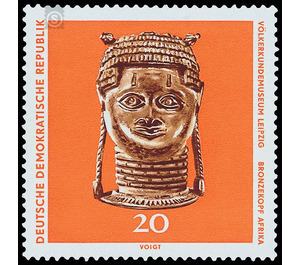Museum of Ethnology, Leipzig: Exhibits - Germany / German Democratic Republic 1971 - 20 Pfennig
Theme: Architecture
| Country | Germany / German Democratic Republic |
| Issue Date | 1971 |
| Face Value | 20.00 |
| Color | orange |
| Perforation | K 13 |
| Printing Type | Photogravure |
| Stamp Type | Postage stamp |
| Item Type | Stamp |
| Chronological Issue Number | 1375 |
| Chronological Chapter | GER-DDR |
| SID | 468251 |
| In 40 Wishlists | |
From the Museum of Ethnology in Leipzig The Ministry of Posts and Telecommunications of the German Democratic Republic publishes four multicolored special postage stamps depicting exhibits from the Museum of Ethnology in Leipzig. Ethnography The originals of the motives of this issue are in the Museum of Ethnology of Leipzig, the largest ethnographic museum on the soil of the German Democratic Republic, whose 100th anniversary roughly coincides with the appearance of this series. The brand motifs represent the four non-European continents represented in the museum's exhibitions: Australia / Oceania, Africa, Asia and America. It is probably no coincidence that three of the four depicted motifs depict ancestral-cult objects, a world-view prevalent over a long period of social evolution, and consequently happiness and unhappiness, both of the individual and of the human community and its institutions depend on the action of the spirits of deceased ancestors. The ancestral cult objects have always been carefully crafted and preciously decorated; however, according to the different levels of material culture and technical skills of their manufacturers, they are different in shape and material. The 20-pfennig value represents a rare bronze sculpture of a woman's head with curly and Zopffrisur dar. The wound several times around the neck pearl necklace shows the sitter as members of the royal family of the Benin Empire (south of today's Republic of Nigeria). The sculpture was probably made in Udo near the city of Benin in the 18th century after a wax model in "cast in lost form". She shows an ancestress and took her place on the royal altars next to other cult objects. The head as the "seat of judgment" played a major role in the ritual. Such bronze objects were almost exclusively limited to the head of the kings of Benin and were originally made only at their behest by the yellow casters. Dimensions: height 23.5 cm, width up to 16 cm.


